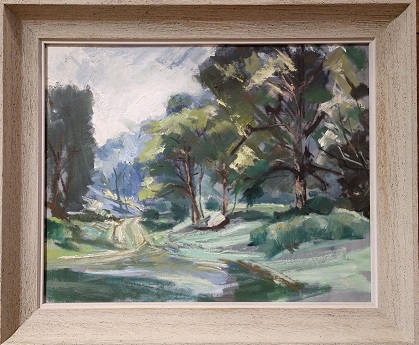|
|
|
|
|
Item #AT-00397Mid Century ôWooded Driveö by Richard Blauvelt Coe (1904-1978)
|
|
|
|
|
Description: ôWooded Driveö
Oil on Canvas
By richard Blauvelt Coe (1904 -1978)
American
Measures: Unframed 16"H x 20"W Framed 19.5" x 23.5"
|

|
|
|
Richard Blauvelt Coe was a Regionalist painter and master etcher of the American South who rose to recognition during the years of the Great Depression. Born in Selma, Alabama in 1904, Coe attended grammar and high schools locally, later enrolling in the Castle Heights Military Academy in Tennessee for what his grandmother described as "prep work."
Coe then went on to Cincinnati for a year where he majored in Architecture. In 1925 Coe won a scholarship sponsored in part by the Birmingham Allied Arts Club and "The Birmingham News-Age-Herald" to study at the Grand Central School of Art with George Elmer Brown. Coe later studied at the School of the Museum of Fine Arts, Boston, with Philip Leslie Hale. There Coe developed an essay entitled "Art and Its Value" while studying with two visiting English artists, Rodney Burne and Robin Guthrie, and through their influence Coe received the Conclave Prize, which awarded him a two-year Page Traveling Scholarship for European Study.
|
![]()
|
|
|
|
|
During this time Coe maintained a studio in Florence, Italy, which he frequented, although most of his time was spent traveling. "Everywhere I was viewing art," Coe stated upon his return in 1934. "I covered most of Italy, Germany, France, Denmark, Scotland and England, and with a chum of mine the trip was made on bicycles. It was wiser to see what Europe has to offer, rather than to study." But soon Coe resumed his study at the Colorado Springs Art School before establishing his studio in Birmingham where he became State Director of Art Projects for Alabama with the Works Progress Administration. "The government is doing its best...and giving work to artists, to do art for the education and delight of the people," Coe told the "Birmingham News". "American art for and by the American people is a slogan worth heeding."
|
![]()
|
|
|
|
|
Coe painted murals in the State Library at Birmingham and at the capitol in Montgomery. He embarked on a series of industrial paintings that reflected labor in Birmingham factories in a style charged with vitality and optimism. He freely welcomed all those interested in art to rendezvous at his studio where he discussed his straightforward insights on painting. "Painting should be a pleasant thing to do and to view," Coe remarked. "Look at a picture...and say 'would you like to be there?' That's one way of telling that you like it, and if you like it, then it's good."
|
![]()
|
|
|
|
Coe specialized in painting portraits, landscapes and structural architecture which received high acclaim throughout the South for their austere restraint of modernism. "If some educated people can't understand the art of a period," Coe commented, "it can't be very important. The art world patronized by a select group which gets into trends and popular fancies is not worth considering." Coe later developed an interest in etching and exhibited this work throughout the United States. He became a member of the National Society of Etchers, as well as a member of the Philadelphia and New Orleans Etching Societies.
|
![]()
|
|
|
|
Coe became an editor on the staff of McCall's Corporation in New York City and conducted art classes at his studio in Mount Kisco, but he discontinued these when he joined the faculty at Harvey School in Katonah. He instructed in wildflower painting at the Kitchawan Extension of the Brooklyn Botanic Garden and taught landscape and graphics at the Bedford Hills Art School.
Coe has had one man shows in Birmingham, Baltimore, New York and Bedford Hills. He and his wife resided in Goldens Bridge, New York and later Baltimore, Maryland where he died in 1978. Submitted February 2005 by Kerry Colonna and compiled and written by her from information obtained from the libraries of Birmingham Museum of Art, Montgomery Museum of Fine Arts, The Baltimore Museum of Art, "The Birmingham News" and the catalog "Painting in the South" published by Virginia Museum in 1983.
|
![]()
|
|
|
|
|
|
|
|
|
|
|
|
|
|
|
|
|
|
|
|
|
|
|
|
|
|
|
|
|
|
|
|
|
|
|
|
|
|
|
|
|
|
|

